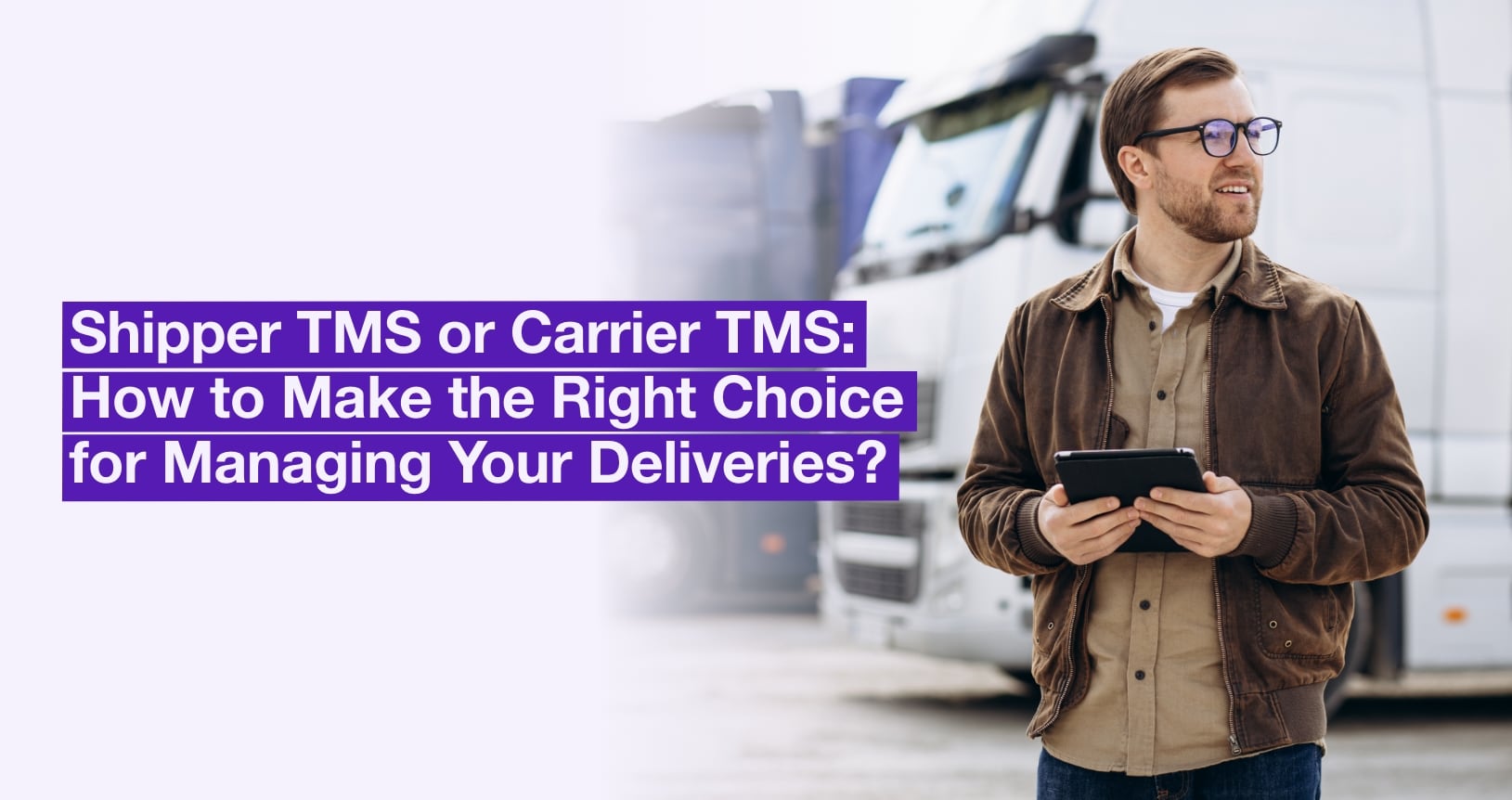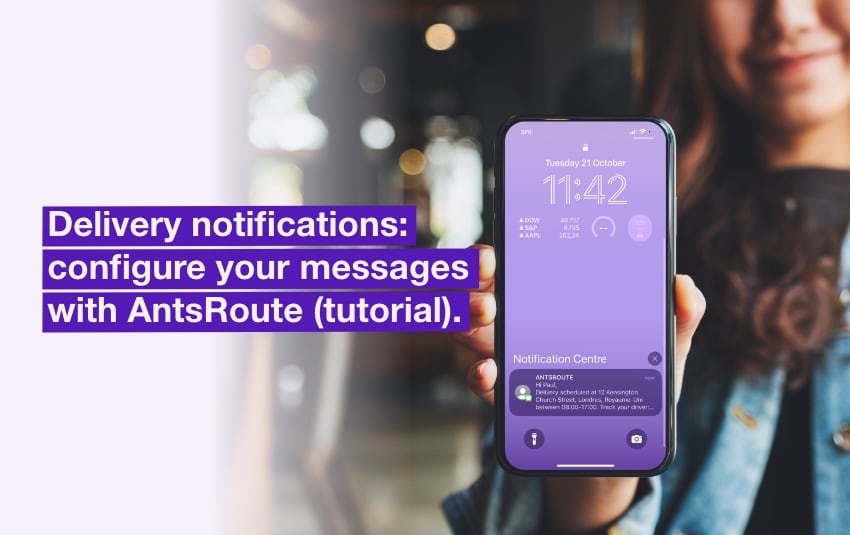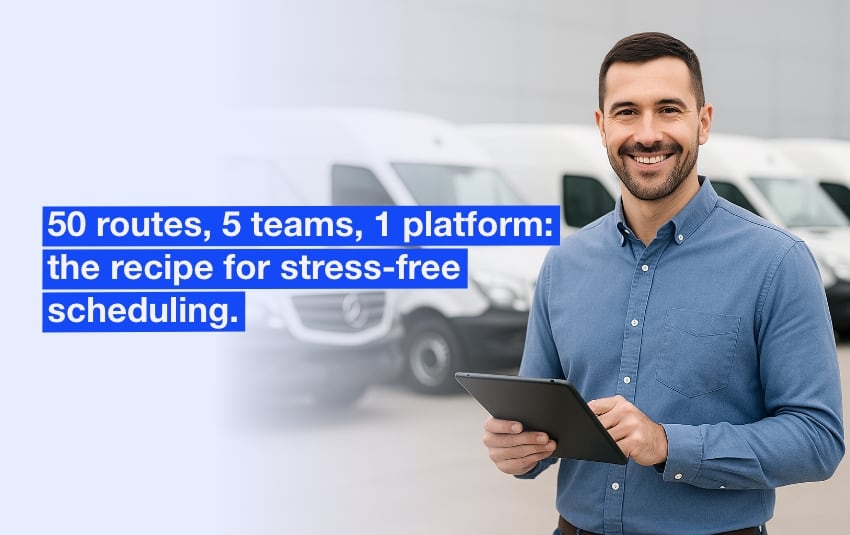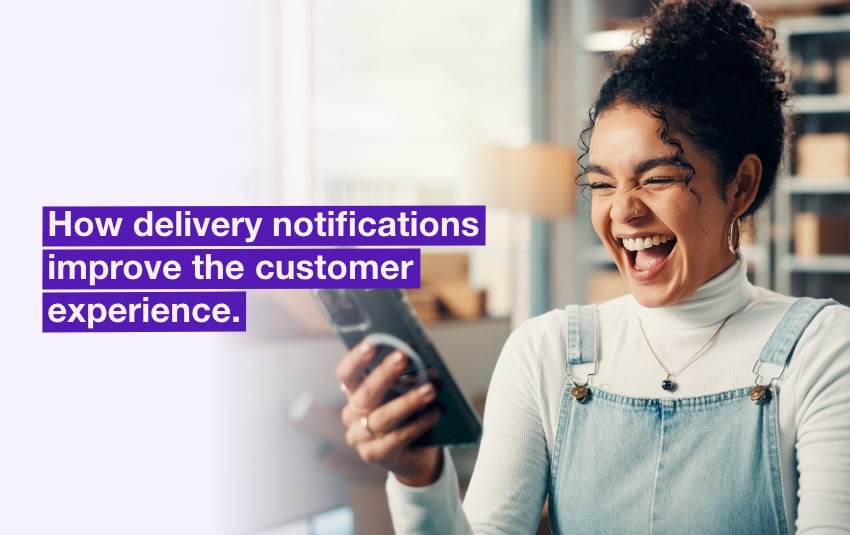Shipper TMS or Carrier TMS: How to Make the Right Choice for Managing Your Deliveries?
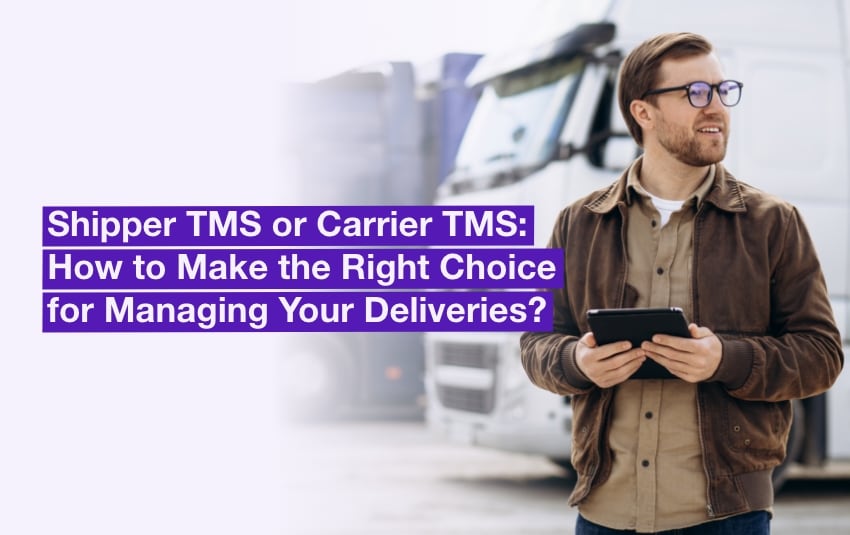
Imagine this: it’s 8:30 a.m., and the customer service phone is already ringing. An irritated B2B client reports that their delivery still hasn’t arrived. You check with your team — the driver did leave, but an unexpected traffic jam has disrupted the planned route. The information hasn’t been updated, the client wasn’t informed, and you’re frantically searching for an updated schedule somewhere between an Excel spreadsheet and a flurry of text messages.
This kind of scenario is all too familiar. It’s typical of industrial, commercial, or e-commerce SMEs that handle their own deliveries and eventually realize that last-mile logistics can no longer be improvised. To keep up with growing volumes, rising customer expectations, and operational pressure, many turn to TMS — Transportation Management Systems.
But very quickly, one key question arises:
Should you choose a Shipper TMS or a Carrier TMS?
And more importantly, what’s the actual difference between the two?
This article is here to help you see things clearly—not in theory, but based on your real-world operations. You’re not a carrier; you ship your own orders to your customers using your own drivers. And that’s exactly why choosing the right tool can make all the difference.
Table of contents:
- Understanding the Difference: Two TMS Options, Two Business Models
- What Are Your Real Needs?
- Why a Carrier TMS Is Often… Too Complex (and Don’t Match Your Real Needs)
- Why a Shipper TMS Like AntsRoute Is the Right Choice for You
Understanding the Difference: Two TMS Options, Two Business Models
When people hear “TMS,” they often picture a massive transport hub, complex freight flows, and endless paperwork to process… and sometimes think, “That’s probably too much for my business.”
The reality? There are actually two types of TMS, and they serve very different needs.
The Shipper TMS: For Companies That Deliver Their Own Products
A Shipper TMS is a logistics planning tool designed for businesses that handle deliveries themselves—most likely, that includes you. Are you a furniture manufacturer, a food distributor, or a niche e-commerce business? You manage your own delivery routes, track parcels, and keep your customers informed.
Your core business isn’t transportation—It’s the successful delivery of the promises you make to your customers.
A Shipper TMS like AntsRoute helps you:
- Automatically plan your delivery routes based on your constraints (time windows, zones, volumes)
- Adjust routes in case of disruptions
- Notify your customers about expected delivery times (ETA)
- Track your drivers in real time
- Centralize all delivery data in clear, actionable dashboards
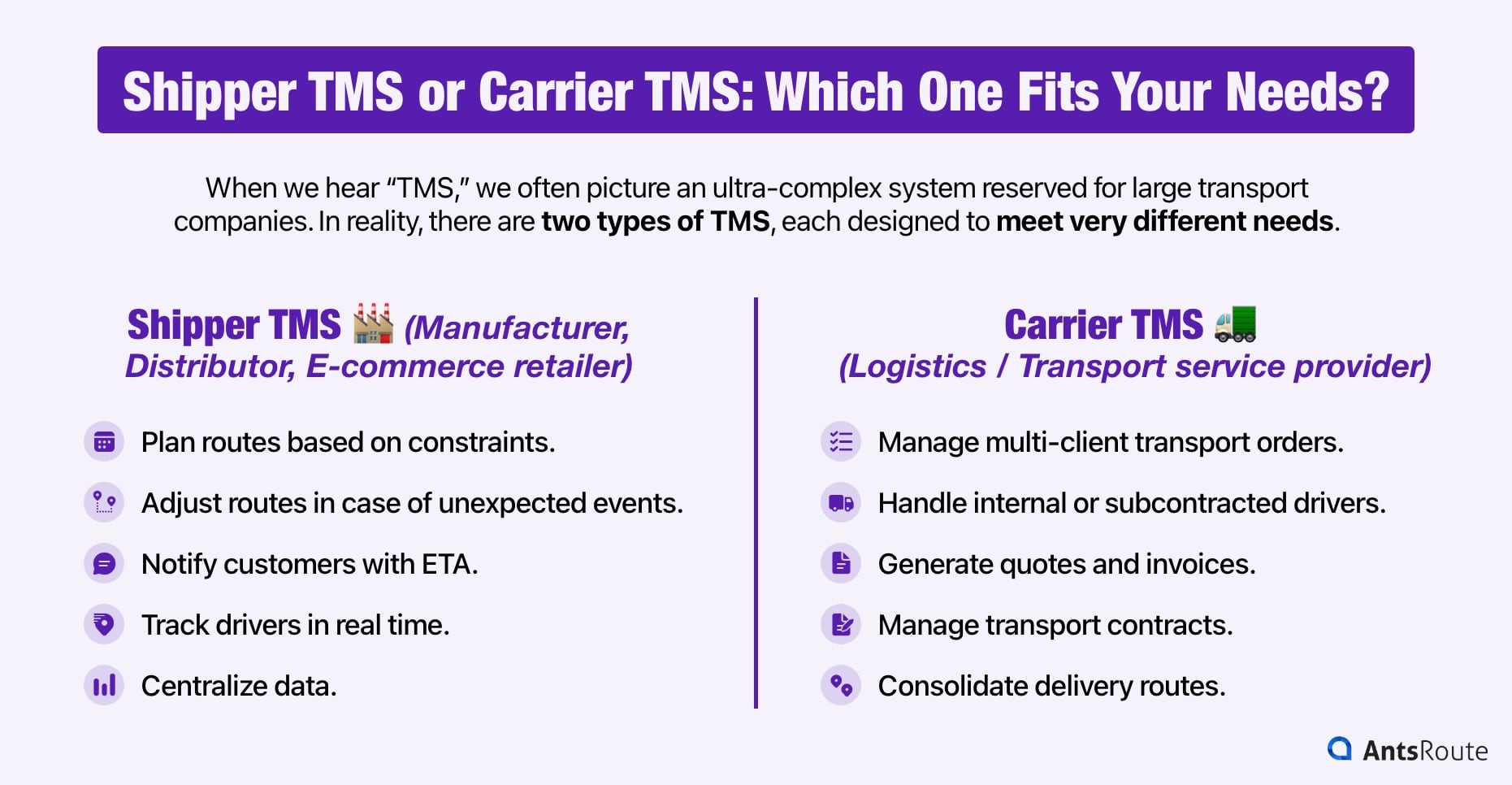
Shipper TMS or Carrier TMS: Which needs do they meet?
The Carrier TMS: For Those Whose Business Is… Transporting for Others
The Carrier TMS, on the other hand, is designed for transport companies. Its purpose is to help manage transportation services on behalf of third-party clients. An example of a TMS built for carriers is Ready, developed by the Sinari Group.
It supports features such as:
- Managing multi-client transport orders
- Assigning deliveries to in-house or subcontracted drivers
- Generating quotes and invoices
- Handling transport contracts
- Consolidating delivery routes for multiple shippers
If you’re a carrier, this type of TMS can significantly boost your efficiency and profit margins. You can learn more about its benefits in our article: The Benefits of a TMS for a Transport Company.
However, if you’re not a transport provider yourself, this kind of tool is often too complex, too expensive, and not aligned with your actual priorities.
In summary:
| Shipper TMS | Carrier TMS | |
| Do you ship your own products? | ✅ Yes – Fully adapted | ❌ Too focused on subcontracting |
| Do you have an internal fleet? | ✅ Managed and optimized | ✅/❌ Depends on business model |
| Are your client the final recipients? | ✅ Direct communication with recipients | ❌ Focused on B2B for third parties |
| Do you invoice for transport? | ❌ No – Included in the service | ✅ Yes – Transport is a billed service |
AntsRoute: A Flexible and Hybrid Solution
Although AntsRoute is primarily designed as a Shipper TMS, many professional transport companies now use it to manage deliveries on behalf of major retail brands.
This is especially true for transport providers receiving delivery orders via the Woop platform—a next-generation freight exchange.
Thanks to the AntsRoute ↔ Woop connector, these carriers can:
- Automatically retrieve delivery orders from Woop’s partner brands
- Build optimized delivery routes based on their fleet directly in AntsRoute
- Track deliveries in real time and send delivery data back to Woop
☝️ While AntsRoute isn’t a Carrier TMS in the traditional sense, its flexibility and API connectors make it a perfect fit for modern transporters seeking agility and automation—without the complexity of legacy systems.
What Are Your Real Needs?
If we had to sum up the expectations of a small or medium-sized business that manages its own deliveries in one sentence, it would probably be this:
“I want my routes to be easy to organize, my customers to be satisfied, and my teams to stop wasting time on inefficient processes.”
And yet, many companies still adopt tools that are too complex, poorly suited, or designed for entirely different use cases. Before choosing a TMS, the real question isn’t “Which software is the most feature-rich?” but rather:
“What do I actually need, day to day, to deliver to my customers more efficiently?”
A Need for Simplicity, Not Complexity
For most small and mid-sized industrial, commercial, or e-commerce businesses, logistics needs are primarily operational:
- Planning delivery routes while accounting for business constraints (time windows, zones, volumes, vehicle capacity).
- Tracking drivers in the field.
- Automatically notifying customers in case of delays or changes.
- Providing a reliable delivery experience.
- Reducing inbound calls to customer service.
- Saving time during planning.
At this stage, we’re not talking about subcontracting, transport billing for third parties, or multi-carrier management. We’re talking about operational efficiency, agility, and customer service.
Quick Checklist: Your Logistics Priorities
Here’s a simple framework to help you reflect on what really matters for your business:
| Needs | Is this a priority for you? |
| Automate route planning? | ✅ |
| Adjust routes based on traffic conditions? | ✅ |
| Track vehicles in real time? | ✅ |
| Automatically notify customers? | ✅ |
| Collect proof of delivery? | ✅ |
| Reduce incoming calls to customer service? | ✅ |
| Invoice transport services to third-party clients? | ❌ |
| Manage subcontracted carriers? | ❌ |
If you answered “yes” to the first few items, you fit the profile of a Shipper, and you need a TMS designed to manage your own deliveries. Not one built to handle transport services sold to third parties.
What You Should Look for in a Tool
When choosing a TMS, don’t start with a feature checklist—start with the real, day-to-day challenges you face.
A good tool should help you:
- Respond quickly to unexpected events (rescheduling, customer no-show, traffic).
- Provide visibility to both your teams and your customers.
- Measure what’s working—and what’s not—using logistics KPIs.
- Connect seamlessly with your existing tools: ERP, CRM, e-commerce platform.
That’s exactly what AntsRoute offers: a user-friendly interface designed for SMEs, with no unnecessary complexity and a 100% field-oriented approach.

A TMS should enable you to assess delivery performance using reliable logistics KPIs.
Why a Carrier TMS Is Often… Too Complex (and Don’t Match Your Real Needs)
It’s not uncommon to see SMEs that ship their own goods adopt a Carrier TMS… only to realize a few weeks later that they’ve set up an overly complex system to solve a much simpler problem.
The issue doesn’t lie with the software itself. A Carrier TMS can be a powerful tool… for transport companies. The problem is that it simply wasn’t built for your line of work.
A System Built for Transport Operations… Not for Customer Deliveries
A Carrier TMS is primarily designed for businesses whose core activity is selling transport services to third-party clients. It addresses very specific needs, such as:
- Managing multiple shipper clients,
- Generating transport quotes and invoices,
- Tracking subcontracted carriers,
- Assigning transport orders across various service providers,
- Optimizing multi-flow, multi-contract operations.
Powerful features—yet they quickly become overwhelming, even counterproductive, if you’re managing your own deliveries, with your own drivers, for your own customers.
Here’s what we often hear from SMEs that tried Carrier TMS solutions before switching to a tool like AntsRoute:
- “Everything had to be configured manually—it took days.”
- “The system kept asking us to validate transport quotes… that we don’t even sell.”
- “Too many features, too much setup, not enough simplicity.”
The result?
- Teams reluctant to adopt the tool.
- Time wasted every time a new route needs to be planned.
- An organization that becomes dependent on a rigid system.
- And often, a step backward—followed by the search for a simpler, more suitable solution like AntsRoute.
Clear Comparison: Shipper vs. Carrier TMS
| Features | Shipper need | Required for a carrier |
| Internal route planning | ✅ Essential | ✅ Essential |
| Multi-client (third-party) management | ❌ Unnecessary | ✅ Indispensable |
| Transport quote generation | ❌ Not relevant | ✅ Yes |
| Subcontractor management | ❌ Rarely | ✅ Common |
| Transport invoicing | ❌ Not applicable | ✅ Key feature |
| End-customer delivery tracking | ✅ Priority | Depends on the business |
| E-commerce / ERP connectors | ✅ Crucial | Variable |
Industry Anecdote
A client in the furniture sector told us about their experience testing a Carrier TMS offered by a logistics provider:
“The tool was extremely comprehensive—too much, actually. We spent all our time bypassing unnecessary steps. All we wanted was to plan our deliveries, keep our customers informed, and optimize our fleet—not manage transport contracts for other companies.”
Since switching to AntsRoute:
- Delivery schedules are generated in just a few clicks
- Customer service has real-time visibility
- Drivers use an intuitive mobile app
- And most importantly… no more wasted time on irrelevant features.
✅ The takeaway:
A Carrier TMS is an excellent solution—if you’re a carrier.
But if your business is shipping your own products to your customers — and you’re looking to simplify delivery management, not make it more complex — then you probably don’t need all that infrastructure.
What you need is a TMS that understands your business, your constraints, and your pace.
And that’s exactly what AntsRoute offers.
Why a Shipper TMS Like AntsRoute Is the Right Choice for You
When you manage your own deliveries, you don’t need a system built to handle hundreds of subcontractors.
You need a tool that works like you do: fast, reliable, easy to use, and ready to handle daily disruptions.
That’s exactly what AntsRoute delivers: a modern Shipper TMS, designed for companies that ship their own goods with their own drivers — while maintaining a high standard of customer service.
AntsRoute: A Complete Toolbox — Without the Overload
AntsRoute brings together everything you need to manage your deliveries from end to end:
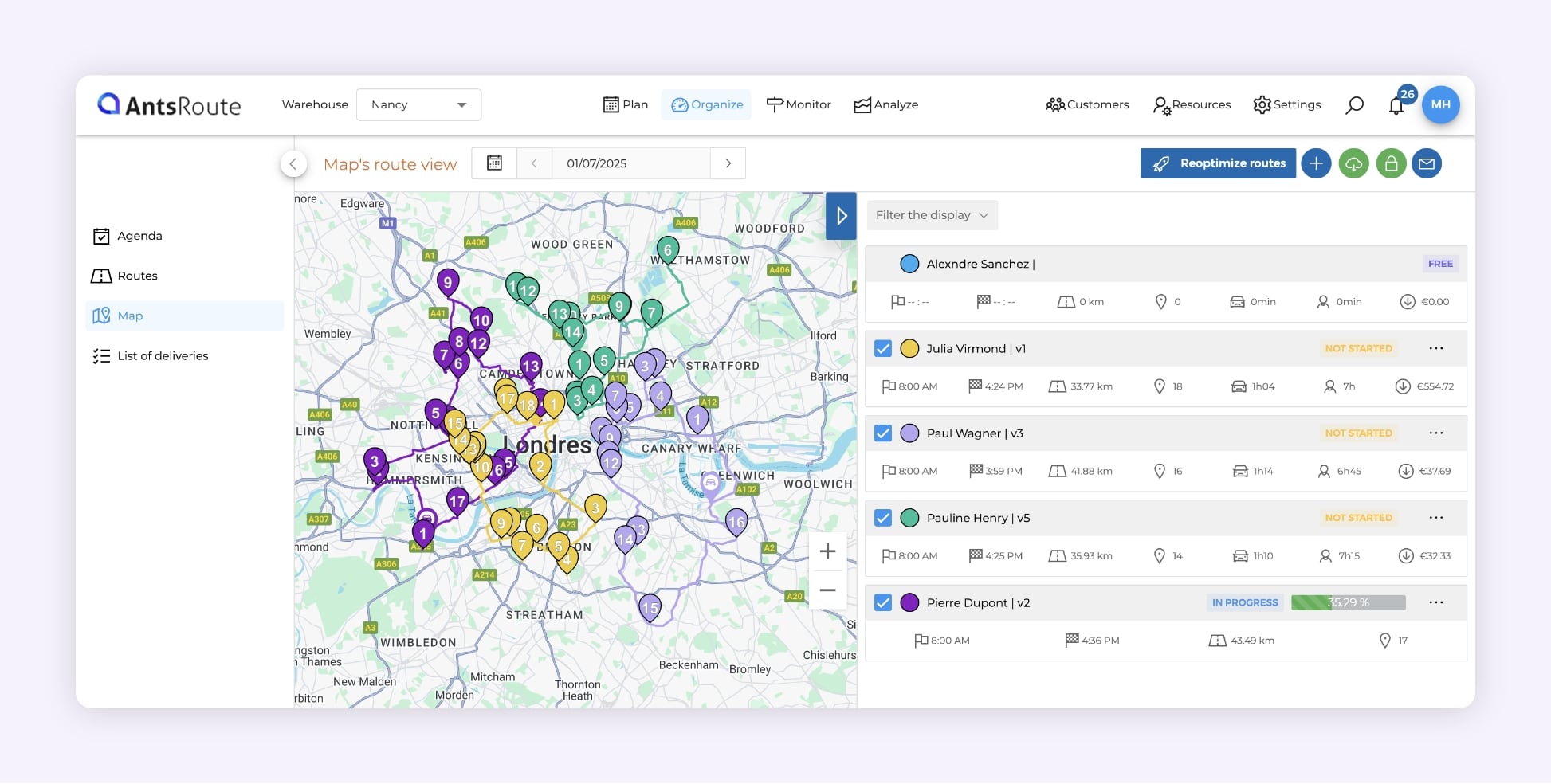
AntsRoute route optimization software.
✅ Smart route planning. Optimized routes are generated automatically based on:
- Customer time window preferences
- Covered geographic zones
- Vehicle capacity
- Specific business constraints (product types, stop durations, etc.).
“Home delivery is an open and highly competitive sector. Tech Express’s strength lies in its adaptability. Thanks to AntsRoute, we can adapt precisely to our clients’ requests and work transparently and very efficiently.” – Farid Saidani, Operations Director at Tech Express
✅ Customer Notifications:
- Automatic SMS or email alerts sent to customers before the driver’s arrival
- Live tracking link
- ne-click rescheduling or confirmation option.
✅ Driver Mobile App:
- Clear, optimized route overview
- Navigation via Google Maps or Waze
- Integrated proof of delivery (signature, photos, barcode scanning).
✅ Dashboards & Performance Metrics:
- On-time delivery rate
- First-attempt delivery success rate
- Average time per route and per delivery
- Average cost per route and per delivery.
“AntsRoute is incredibly useful for tracking performance across our different routes. Some take 5 hours, others 8. But why? What’s related to the driver, and what’s related to the route? The data provided by the software helps us better understand the source of these differences, so we can adjust certain routes and organize ourselves more effectively.” – Véronique Pfister, Technical Supervisor at Ferme Saint-André
✅ Easy Integrations:
- Sync with your business tools (ERP, CRM, e-commerce, etc.)
- API connectors and webhooks to automate data exchange.
Real-World Example: Furniture Delivery — A Logistics Operation in Its Own Right
Let’s take the example of one of our clients specialized in delivering high-end furniture.
⚠️ Before AntsRoute:
- Delivery schedules were created manually in Excel.
- Customers were not informed of delivery times.
- Any route change triggered a cascade of internal phone calls.
✅ With AntsRoute :
- Routes are automatically generated each day, based on weight, volume, and customer time slots.
- Drivers use the mobile app to confirm deliveries.
- Customers receive notifications the day before and 30 minutes before the driver arrives.
- Customer service can track every step of the delivery route in real time.
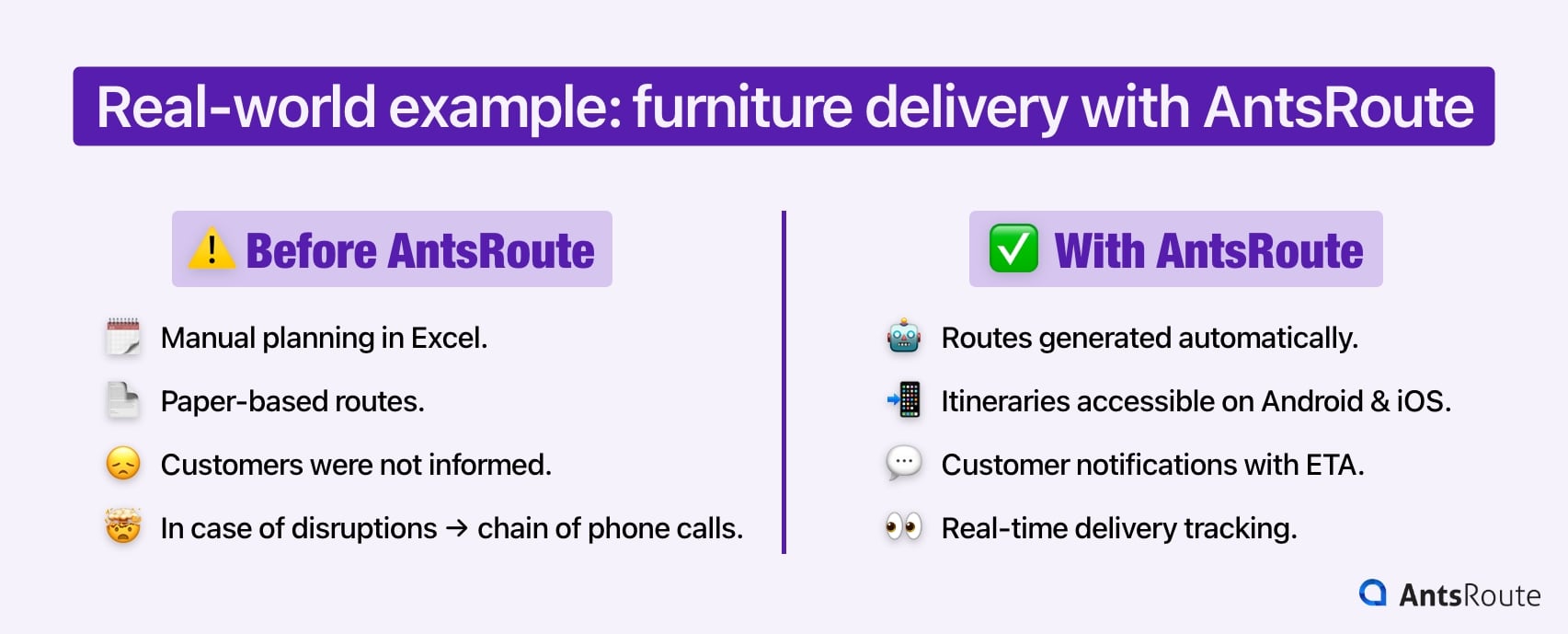
Real-world example: furniture delivery with AntsRoute
And Even… for Modern Transport Companies
Although AntsRoute was designed as a Shipper TMS, it also meets the needs of certain transport carriers.
Especially those delivering on behalf of partner retailers via platforms like Woop.
Thanks to its connector with Woop, AntsRoute enables these carriers to:
- Automatically import customer orders from the Woop platform
- Build smart delivery routes using their own fleet
- Send delivery proofs and status updates directly into the Woop ecosystem.
The result: simplified operations, automated data exchange, and smoother logistics—even when working with multiple clients.
Conclusion
Choosing between a Shipper TMS and a Carrier TMS should never be based solely on a technical spec sheet or a marketing promise. It should start with your day-to-day business reality:
- Do you manage your own delivery routes?
- Are your drivers employed by your company?
- Do your customers expect on-time delivery slots, notifications, and a smooth experience?
Then you’re a Shipper, and you need a tool built for you.
Not to manage subcontractors. Not to generate transport quotes.
Not to oversee freight contracts.
Beyond choosing between a Shipper or Carrier TMS, another key factor is the deployment model: SaaS or on-premise. To understand the pros and cons of each and find the best fit for your company, check out our dedicated guide.
You need a TMS that helps you deliver better, faster, and with less stress.
That’s exactly what AntsRoute offers: an agile platform designed to simplify your operations, lower your logistics costs, and above all, boost your service quality.
See yourself in the scenarios described above? Try AntsRoute free for 7 days — no commitment, no complex setup. Just a business-ready solution built to make your life easier.
WRITTEN BY

Marie Henrion
At AntsRoute, Marie has been the marketing manager since 2018. With a focus on last-mile logistics, she produces content that simplifies complex topics such as route optimization, the ecological transition, and customer satisfaction.
Free 7-day trial | No credit card required
Contenu
- Understanding the Difference: Two TMS Options, Two Business Models
- The Shipper TMS: For Companies That Deliver Their Own Products
- The Carrier TMS: For Those Whose Business Is… Transporting for Others
- In summary:
- AntsRoute: A Flexible and Hybrid Solution
- What Are Your Real Needs?
- A Need for Simplicity, Not Complexity
- Quick Checklist: Your Logistics Priorities
- What You Should Look for in a Tool
- Why a Carrier TMS Is Often… Too Complex (and Don’t Match Your Real Needs)
- A System Built for Transport Operations… Not for Customer Deliveries
- Complexity = hidden costs + loss of agility
- Clear Comparison: Shipper vs. Carrier TMS
- Industry Anecdote
- Why a Shipper TMS Like AntsRoute Is the Right Choice for You
- AntsRoute: A Complete Toolbox — Without the Overload
- Real-World Example: Furniture Delivery — A Logistics Operation in Its Own Right
- And Even… for Modern Transport Companies
- Conclusion

